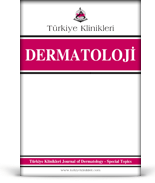Objective: Seborrheic dermatitis (SD) is a common, chronic, recurring, inflammatory skin disorder. The cause of the disease is still completely unknown. Recent studies suggest that Demodex parasites may play a role in the etiopathogenesis of SD. The purpose of this study was, to investigate the presence of Demodex in SD and its association with disease severity. Material and Methods: A total of 40 patients over the age of 18 years, who were clinically diagnosed with SD, and 40 healthy control subjects were included in the study. The skin surface biopsy method was used to detect Demodex parasites on lesional and non-lesional skin of the patients and healthy skin of the control group. The Seborrheic Dermatitis Area Severity Index was used to calculate disease severity. The presence of 5 or more Demodex parasites per square centimeter was considered positive. Results: While Demodex parasites were found in 50% of the lesional skin and in 2.6% of the non-lesional skin of the patients, 12.5% of the control group (p<0.001) had Demodex parasites. No relationship was found between the presence of Demodex parasites in the lesional skin and the severity index of the SD area. Conclusion: In this study, we found that the presence of Demodex was more prevalent in SD lesions than in control skin and lesion-free skin. A member of the microbiota, Demodex may be a predisposing factor in the development of SD.
Keywords: Demodex; pathogenesis; seborrheic dermatitis; standardized skin surface biopsy
Amaç: Seboreik dermatit (SD); yaygın, kronik, tekrarlayan, inflamatuar bir deri hastalığıdır. Nedeni hâlâ tam olarak anlaşılamamıştır. Son çalışmalar, Demodeks akarlarının SD etiyopatogenezinde rol oynayabileceğini düşündürmektedir. Bu çalışmada, SD'de Demodeks varlığını ve hastalık şiddeti ile ilişkisini araştırmayı amaçladık. Gereç ve Yöntemler: Çalışmaya, klinik olarak SD tanısı konan 18 yaş üstü 40 hasta ve 40 sağlıklı kontrol alındı. Hastaların lezyonlu ve lezyonsuz derileri ile kontrol grubunun sağlıklı derilerinden Demodeks akarlarını saptamak için deri yüzey biyopsisi yöntemi kullanıldı. Hastalık şiddetini hesaplamak için Seboreik Dermatit Alan Şiddet İndeksi kullanıldı. Demodeks'in cm2de 5 ve üzerinde olması pozitif kabul edildi. Bulgular: Hastaların lezyonlu ciltlerinde %50, lezyonsuz ciltlerinde %2,6 oranında Demodeks akarı saptanırken, kontrol grubunda bu oran %12,5 idi (p<0,001). Lezyonel deride Demodeks akarlarının varlığı ile SD bölgesinin şiddet indeksi arasında bir ilişki bulunmadı. Sonuç: Bu çalışmada, SD lezyonlarında Demodeks varlığı hem kontrol hem de lezyonsuz deriye göre daha fazla bulundu. Mikrobiyotanın bir üyesi olan Demodeks, SD gelişiminde predispozan bir faktör olabilir.
Anahtar Kelimeler: Demodeks; patogenez; seboreik dermatit; standardize deri yüzeyi biyopsisi
- Dessinioti C, Katsambas A. Seborrheic dermatitis: etiology, risk factors, and treatments: facts and controversies. Clin Dermatol. 2013;31(4):343-51. [Crossref] [PubMed]
- Karincaoglu Y, Tepe B, Kalayci B, Atambay M, Seyhan M. Is Demodex folliculorum an aetiological factor in seborrhoeic dermatitis? Clin Exp Dermatol. 2009;34(8):e516-20. [Crossref] [PubMed]
- Berk T, Scheinfeld N. Seborrheic dermatitis. P T. 2010;35(6):348-52. [PubMed] [PMC]
- Adalsteinsson JA, Kaushik S, Muzumdar S, Guttman-Yassky E, Ungar J. An update on the microbiology, immunology and genetics of seborrheic dermatitis. Exp Dermatol. 2020;29(5):481-9. [Crossref] [PubMed]
- Sampaio AL, Pôrto LC, Ramos-e-Silva M, Nunes AP, Cardoso-Oliveira J, Fabricio-Silva GM, et al. Human leucocyte antigen frequency in a miscegenated population presenting with seborrhoeic dermatitis. J Eur Acad Dermatol Venereol. 2014;28(11):1576-7. [Crossref] [PubMed]
- Karakadze MA, Hirt PA, Wikramanayake TC. The genetic basis of seborrhoeic dermatitis: a review. J Eur Acad Dermatol Venereol. 2018;32(4):529-36. [Crossref] [PubMed]
- Zhao YE, Wu LP, Peng Y, Cheng H. Retrospective analysis of the association between Demodex infestation and rosacea. Arch Dermatol. 2010;146(8):896-902. Erratum in: Arch Dermatol. 2010;146(12):1412. [Crossref] [PubMed]
- Yazıcı AC, İkizoğlu G. Demodicosis. Turkiye Klinikleri J Med Sci. 2019;39(2):231-6. [Crossref]
- Rather PA, Hassan I. Human demodex mite: the versatile mite of dermatological importance. Indian J Dermatol. 2014;59(1):60-6. [Crossref] [PubMed] [PMC]
- Karincaoglu Y, Bayram N, Aycan O, Esrefoglu M. The clinical importance of demodex folliculorum presenting with nonspecific facial signs and symptoms. J Dermatol. 2004;31(8):618-26. [Crossref] [PubMed]
- Zhao YE, Peng Y, Wang XL, Wu LP, Wang M, Yan HL, et al. Facial dermatosis associated with Demodex: a case-control study. J Zhejiang Univ Sci B. 2011;12(12):1008-15. [Crossref] [PubMed] [PMC]
- Zhao YE, Hu L, Wu LP, Ma JX. A meta-analysis of association between acne vulgaris and Demodex infestation. J Zhejiang Univ Sci B. 2012;13(3):192-202. [Crossref] [PubMed] [PMC]
- Aktaş Karabay E, Aksu Çerman A. Demodex folliculorum infestations in common facial dermatoses: acne vulgaris, rosacea, seborrheic dermatitis. An Bras Dermatol. 2020;95(2):187-93. [Crossref] [PubMed] [PMC]
- Cömert A, Bekiroglu N, Gürbüz O, Ergun T. Efficacy of oral fluconazole in the treatment of seborrheic dermatitis: a placebo-controlled study. Am J Clin Dermatol. 2007;8(4):235-8. [Crossref] [PubMed]
- Borda LJ, Wikramanayake TC. Seborrheic dermatitis and dandruff: a comprehensive review. J Clin Investig Dermatol. 2015;3(2):10.13188/2373-1044.1000019. [Crossref] [PubMed] [PMC]
- Schwartz JR, Messenger AG, Tosti A, Todd G, Hordinsky M, Hay RJ, et al. A comprehensive pathophysiology of dandruff and seborrheic dermatitis-towards a more precise definition of scalp health. Acta Derm Venereol. 2013;93(2):131-7. [Crossref] [PubMed]
- Forton F, De Maertelaer V. Erythematotelangiectatic rosacea may be associated with a subclinical stage of demodicosis: a case-control study. Br J Dermatol. 2019;181(4):818-25. [Crossref] [PubMed]
- Moran EM, Foley R, Powell FC. Demodex and rosacea revisited. Clin Dermatol. 2017;35(2):195-200. [Crossref] [PubMed]
- Yazısız H, Çekin Y, Koçlar FG. The presence of demodex parasites in patients with dermatologic symptoms of the face. Turkiye Parazitol Derg. 2019;43(3):143-8. [Crossref] [PubMed]
- Chen W, Plewig G. Human demodicosis: revisit and a proposed classification. Br J Dermatol. 2014;170(6):1219-25. [Crossref] [PubMed]
- Dhingra KK, Saroha V, Gupta P, Khurana N. Demodex-associated dermatologic conditions--A coincidence or an etiological correlate. Review with a report of a rare case of sebaceous adenoma. Pathol Res Pract. 2009;205(6):423-6. [Crossref] [PubMed]
- Demirdağ HG, Özcan H, Gürsoy Ş, Beker Akbulut G. The effects of sebum configuration on Demodex spp. density. Turk J Med Sci. 2016;46(5):1415-21. [Crossref] [PubMed]
- Akilov OE, Mumcuoglu KY. Association between human demodicosis and HLA class I. Clin Exp Dermatol. 2003;28(1):70-3. [Crossref] [PubMed]







.: İşlem Listesi